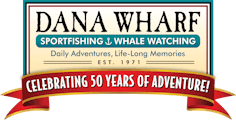The Importance of Giant Kelp

by Eric Austin Yee
One of the most overlooked natural features while on our whale watching trips is giant kelp. That brownish-green mess you see piled up on the beach or floating on the surface of the ocean is actually a super important part of a unique habitat important to our coast. Dense patches of giant kelp create kelp forest along our coastline that is home to over a thousand species of aquatic animals. Not only does wildlife benefit from giant kelp, but us humans actually can benefit from it too!
The most abundant and most frequently seen type of giant kelp off the coast of Southern California is Macrocystis pyrifera aka giant kelp or giant bladder kelp. Even though it has very plant-like features, giant kelp is actually the largest form of algae, reaching lengths of 175 feet. Giant kelp can be found growing along the entire coastline of North America. Only four other places in the world have the right conditions for giant kelp to grow. A combination of the right temperature, water clarity and water quality allow giant kelp to flourish. When conditions are just right, giant kelp can grow up to two feet a day!
Kelp forests line a large portion of the coastline that Dana Wharf Whale Watching explores. These kelp forests are the habitat for countless fish and invertebrates. Some of the most commonly seen fish in the kelp forest are calico bass, garibaldi, and sheephead. The root structure of giant kelp, known as the holdfast has been documented to be home to up to 178 species of invertebrates. Giant kelp that grows to the surface of the ocean help creates a structure called the kelp canopy. From the top of the kelp forest at the kelp canopy, to the bottom at the holdfast, the kelp forest can be a shelter, hunting ground and nursery for many species. Strong currents, storms and even sea urchins that dine on the holdfast of giant kelp, will cause the giant kelp to break free from the kelp forest and into the open ocean. Strands of giant kelp will break free together to make what is known as a kelp paddy. Kelp paddies will drift miles out to sea and become another small habitat for certain animals. Small baitfish, juvenile fish and even sea birds can be seen using the kelp paddy for shelter or a resting spot.
The kelp forest along the coastline of Southern California also helps us humans in a many surprising ways too. Since kelp forest typically grows close to shore, it acts as a barrier to buffer the power of currents and waves. This helps slow erosion along our coastline and prevent loss of sand from our beaches. Giant kelp has also been used as a food supplement due to its high amounts of potassium and iodine. A substance call algin is also extracted from kelp and used in many products we use on a daily basis. Algin is used as an emulsifier to help certain ingredients in food and chemicals to mix. It is also used to thicken or smooth out products such as ice cream, paints, and toothpaste.
With the upcoming possibility of many gray whale calves coming up and down our coastline. Some lucky Dana Wharf Whale Watching guest might get to experience another amazing thing our kelp forest has to offer. Gray whale mothers and calves tend to travel along and even right through our surrounding kelp forest. Gray whales use the kelp forest has a safe haven from transient/Bigg’s killer whales that frequently target gray whale calves for food. Even when no killer whales are near, gray whales frequently will cruise through the kelp forest, often spy hopping with strands of kelp dangling from them and occasionally rolling in the kelp canopy.
